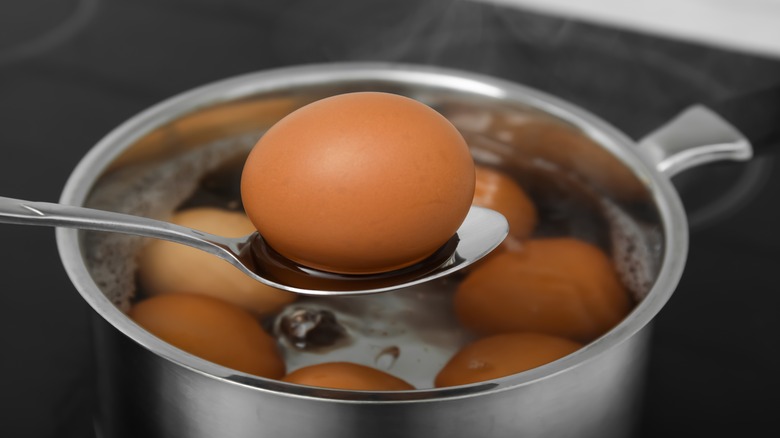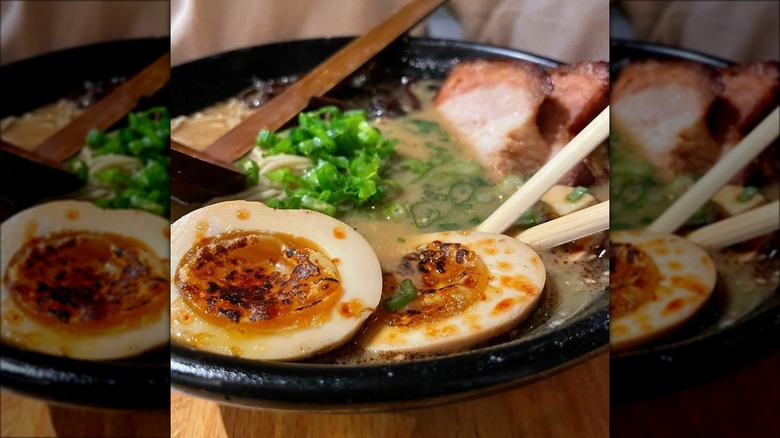Give Your Boiled Eggs The Crème Brûlée Treatment And Thanks Us Later
You might think brûlée is a dessert, but it's actually a cooking method. So, beyond decadent sweets that are torched and caramelized, it's a method that can be used on eggs, too. Brûléeing works best with custardy, and creamy textures, and depending on how it's cooked, a hard-boiled egg meets those criteria. We'll be the first to admit that dessert and hard-boiled eggs aren't exactly synonymous, and giving eggs the crème brûlée treatment sounds a little unusual. But let's not forget, egg yolks are a key element in crème brûlée, so egg brûlée is a breakfast and brunch adventure worth taking.
Naturally, hard-boiled eggs have a mild taste accented by subtle notes of buttery richness, making them the perfect provision to dress up in experimental flavors. To fashion this sophisticated egg dish, simply boil an egg until the yolk develops a creamy, jelly-like consistency. Peel and cut the egg and season it with salt and sugar before torching it to perfection. The sweet, caramelized sugar and the slightly salty taste of the hard-boiled egg yolks work together for a decadent contrast that's equal parts surprising and delicious, and the crystalized top layer gives way to a lush and silky yolk that oozes with flavorful bravado.
Simple tips for making boiled egg brûlée
Don't let the fancy name fool you: Preparing boiled egg brûlée is something amateurs can hack as easily as any Michelin-starred chef. However, you should keep a few tips in mind to perfect this cosmopolitan egg dish.
Eating isn't just about taste; it's a full sensory experience, and even if you typically prefer your boiled eggs firm, overcooking is egg brûlée's biggest enemy. If the egg is overdone, the surface might already be excessively dry, and torching it won't do you any favors. A creamy, runny yolk facilitates a decadent mouthfeel that bolsters a mouthwatering textural contrast. About five-and-a-half minutes of boiling — if you're cooking six eggs — will give you the perfect yolk to brûlée.
When it comes to selecting the type of sugar for boiled egg brûlée, don't overcomplicate things. A pinch of classic table sugar caramelizes evenly and makes for a sensational crunch. Due to its molasses content, brown sugar burns too quickly, and because it absorbs liquid, powdered sugar causes a clumpy, uneven crust.
Because lighters burn upwards and matches are too weak of a flame, a kitchen torch is essential for developing that glossy, crystalline crust. A torch works fast, operates on high heat, and facilitates precise control. Set the torch to low heat and remove the flame once the yolk begins to bubble and crystalize.
The best ways to pair boiled egg brûlée
Boiled egg brûlée is delicious on its own. However, if you want to use your sweet and crunchy eggs in a larger meal, there are plenty of ways to introduce them into satiating entrées and snackable smorgasbords.
Remix a classic Cobb salad by substituting plain boiled eggs for those that have been graced with sugar and fire. The caramelized taste of the egg complements the umami and earth-forward flavor profiles of the mixed greens, avocado, bacon, and cherry tomatoes. Plus, the creamy yolk imparts a layer of plush richness that makes each forkful luscious, tender, and crunchy.
Serve your brûléed eggs on toasted bread or crostini for something simple yet satisfying. When paired with a fatty spread like avocado or ricotta drizzled with honey and dusted red pepper flakes, you have a rich, crusty, spicy-sweet toast that makes any morning better. Turn a snack into a meal by adding egg brûlée to a charcuterie board. Its dainty sweetness will complement the meaty machismo of the cured meats while providing a textural contrast to the crunchy nuts, snappable crackers, and crisp pickled veggies.
Whichever way you choose to enjoy and serve them, boiled egg brûlée is an unforgettable way to prepare eggs when you're bored of the humdrum scramble. Don't believe us? Try it for yourself and let your tastebuds do the talking.


